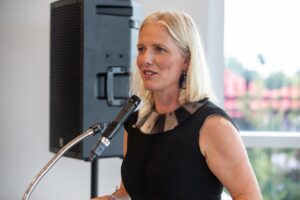On his work’s message
I certainly try to make images that people will want to live with and be engaged by, whether it’s in the museum world or the office or the home, which is where most of my work resides. It becomes part of the fabric of a workplace or a home. And I love that about visual art.
But then I also understand the narrative in all the work that I do: these are the largest examples of human industry on the planet. And we don’t get to see that [here]. So photography and film are great mediums to show what’s happening to the natural world. It is a kind of lament for the loss of nature in all of this. That’s why the piece is buttressed at the beginning and the end with the natural world – to show that we live in it. This whole piece is about it being at risk, risking habitat, risking the systems that support all life.
On the choice of Young-Dundas Square for the premiere and the piece’s concept
Naomi Campbell [artistic director for the Luminato Festival Toronto, which also commissioned and co-produced the piece] approached me four years ago. She was standing at Yonge-Dundas Square and said, you know, ‘it’s so grim.’ It’s concrete and consumerism. It’s just all ads. And that’s when she had the idea to invite an artist to take over all the media screens. So when she asked me, I immediately thought, ‘wouldn’t this be great as a feedback loop, to show the origins of these towers of concrete, glass, steel and copper, and manufacturing of this merchandise.’ I thought it would be great to take all those screens and showcase the other part of the world that allows us the possibility for the urban lives we lead. That was the concept.
It’s not a permanent public work, but it was a very ephemeral, powerful way to engage the square. And I particularly like the idea that somebody could have walked out of Nordstrom with their bag and then, all of a sudden, they have an experience they never expected. It was a fun idea to engage with the community.







